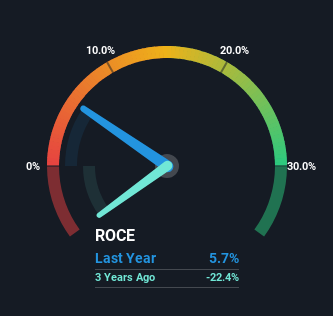- United States
- /
- Energy Services
- /
- NYSE:NINE
Nine Energy Service (NYSE:NINE) Hasn't Managed To Accelerate Its Returns

What trends should we look for it we want to identify stocks that can multiply in value over the long term? Typically, we'll want to notice a trend of growing return on capital employed (ROCE) and alongside that, an expanding base of capital employed. Basically this means that a company has profitable initiatives that it can continue to reinvest in, which is a trait of a compounding machine. Having said that, from a first glance at Nine Energy Service (NYSE:NINE) we aren't jumping out of our chairs at how returns are trending, but let's have a deeper look.
What Is Return On Capital Employed (ROCE)?
For those that aren't sure what ROCE is, it measures the amount of pre-tax profits a company can generate from the capital employed in its business. To calculate this metric for Nine Energy Service, this is the formula:
Return on Capital Employed = Earnings Before Interest and Tax (EBIT) ÷ (Total Assets - Current Liabilities)
0.057 = US$18m ÷ (US$402m - US$83m) (Based on the trailing twelve months to December 2023).
So, Nine Energy Service has an ROCE of 5.7%. Ultimately, that's a low return and it under-performs the Energy Services industry average of 12%.
See our latest analysis for Nine Energy Service

Above you can see how the current ROCE for Nine Energy Service compares to its prior returns on capital, but there's only so much you can tell from the past. If you'd like to see what analysts are forecasting going forward, you should check out our free analyst report for Nine Energy Service .
What Does the ROCE Trend For Nine Energy Service Tell Us?
We've noticed that although returns on capital are flat over the last five years, the amount of capital employed in the business has fallen 69% in that same period. When a company effectively decreases its assets base, it's not usually a sign to be optimistic on that company. In addition to that, since the ROCE doesn't scream "quality" at 5.7%, it's hard to get excited about these developments.
On another note, while the change in ROCE trend might not scream for attention, it's interesting that the current liabilities have actually gone up over the last five years. This is intriguing because if current liabilities hadn't increased to 21% of total assets, this reported ROCE would probably be less than5.7% because total capital employed would be higher.The 5.7% ROCE could be even lower if current liabilities weren't 21% of total assets, because the the formula would show a larger base of total capital employed. With that in mind, just be wary if this ratio increases in the future, because if it gets particularly high, this brings with it some new elements of risk.
What We Can Learn From Nine Energy Service's ROCE
Overall, we're not ecstatic to see Nine Energy Service reducing the amount of capital it employs in the business. Moreover, since the stock has crumbled 88% over the last five years, it appears investors are expecting the worst. In any case, the stock doesn't have these traits of a multi-bagger discussed above, so if that's what you're looking for, we think you'd have more luck elsewhere.
If you'd like to know more about Nine Energy Service, we've spotted 4 warning signs, and 1 of them shouldn't be ignored.
While Nine Energy Service isn't earning the highest return, check out this free list of companies that are earning high returns on equity with solid balance sheets.
Valuation is complex, but we're here to simplify it.
Discover if Nine Energy Service might be undervalued or overvalued with our detailed analysis, featuring fair value estimates, potential risks, dividends, insider trades, and its financial condition.
Access Free AnalysisHave feedback on this article? Concerned about the content? Get in touch with us directly. Alternatively, email editorial-team (at) simplywallst.com.
This article by Simply Wall St is general in nature. We provide commentary based on historical data and analyst forecasts only using an unbiased methodology and our articles are not intended to be financial advice. It does not constitute a recommendation to buy or sell any stock, and does not take account of your objectives, or your financial situation. We aim to bring you long-term focused analysis driven by fundamental data. Note that our analysis may not factor in the latest price-sensitive company announcements or qualitative material. Simply Wall St has no position in any stocks mentioned.
About NYSE:NINE
Nine Energy Service
Operates as an onshore completion services provider that targets unconventional oil and gas resource development in North American basins and internationally.
Undervalued slight.
Similar Companies
Market Insights
Community Narratives



